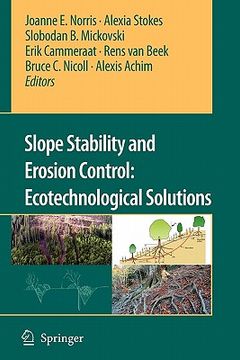Share
slope stability and erosion control: ecotechnological solutions (in English)
Joanne E. Norris
(Illustrated by)
·
Alexia Stokes
(Illustrated by)
·
Springer
· Paperback
slope stability and erosion control: ecotechnological solutions (in English) - Norris, Joanne E. ; Stokes, Alexia ; Mickovski, Slobodan B.
$ 161.04
$ 169.99
You save: $ 8.95
Choose the list to add your product or create one New List
✓ Product added successfully to the Wishlist.
Go to My WishlistsIt will be shipped from our warehouse between
Tuesday, May 14 and
Wednesday, May 15.
You will receive it anywhere in United States between 1 and 3 business days after shipment.
Synopsis "slope stability and erosion control: ecotechnological solutions (in English)"
This chapter describes the processes involved in the transport of material over hillslopes. Hillslopes provide the gradients enabling material to be transported from the slopes themselves towards the valley bottoms, directly by gravity alone, or by water flowing down over the surface. Gravity has the potential to transfer material downslope if the material resistance to counteact it is insufficient. Similarly, water and wind flowing along the surface exert a drag on soil particles and have the potential to entrain material. After the gradient has fallen below a critical threshold to keep the material in tra- port, deposition occurs. Conventionally, slope processes in which gravity alone is the dominant transporting agent are called mass movements (Brunsden 1984). Processes in which other agents dominate are called erosion, e.g. wind or water erosion. Flowing water is an important transporting agent on which the emphasis is placed here. Although mass wasting is a natural process its incidence and impact may be exacerbated by human activities (Crozier 1986; Morgan 2005). A situation may ultimately arise in which human interests become unsafe or unsustainable. This impact is not only directly felt in the areas where material is removed or deposited and indirectly mass wasting may have an effect on soil and water quality in areas located further downstream. In the following sections a brief overview is given of the mechanisms, morphology, causes and consequences of mass movements and erosion.
- 0% (0)
- 0% (0)
- 0% (0)
- 0% (0)
- 0% (0)
All books in our catalog are Original.
The book is written in English.
The binding of this edition is Paperback.
✓ Producto agregado correctamente al carro, Ir a Pagar.

